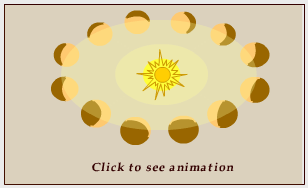
|
||||||||
|
|
||||||||
|
|
|
|
|
|
|
|||
|
|
||||||||
|
SEASONS Find out about alignments --> People often say that the sun rises in the east. That’s not exactly true. If you watch the sun rise each morning over the course of an entire year, you’ll see that the sun doesn’t always rise in the same place.
In the summer, the sun rises somewhat north of due east. The date on which it rises the farthest to the north is roughly June 21, the summer solstice and the longest day of the year in the Northern Hemisphere.
Why does the sun’s path across the sky change throughout the year? The reason is that the earth is tilted—by 23.5 degrees, to be exact—with respect to its orbit.
When it’s summer in the Northern hemisphere, the North Pole is tilted toward the sun and the sun shines on a greater area of the Northern Hemisphere. As the earth spins, places in the Northern Hemisphere stay in the sunlit area longer, and that means the days are longer.
When it’s winter in the Northern Hemisphere, the North Pole is tilted away from the sun, the sun shines on a smaller area of the Northern Hemisphere, and the days are shorter.
|
||||||||

